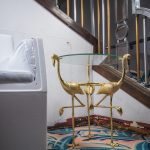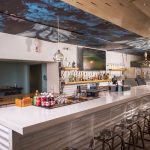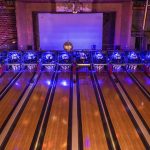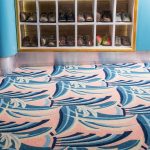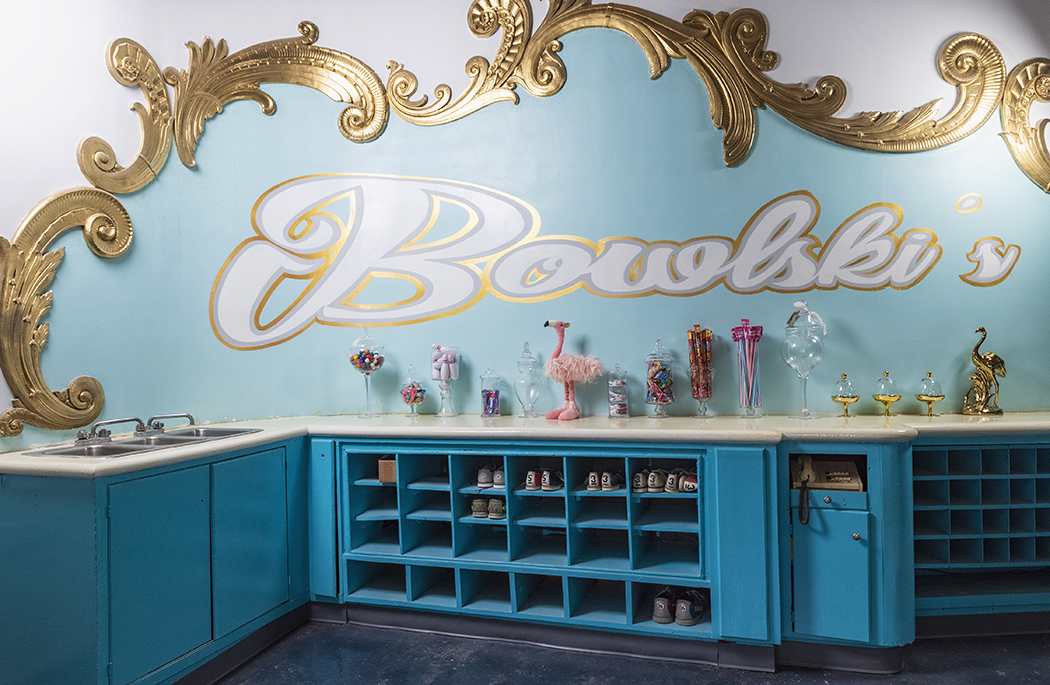
Photo by Danny Fulgencio
For more than 80 years, the Lakewood Theater entertained neighbors with movie screenings, live bands and even burlesque shows. Much has changed since the iconic space opened in 1938, but the theater has remained, at its core, a theater.
That will change this summer when the curtain opens on a new act: Bowlski’s bowling lounge, a 10-lane bowling alley and entertainment center with golf simulators and gaming suites.
The new kingpins in charge are Craig and Jennifer Spivey — Lakewood neighbors, avid bowlers and veteran entrepreneurs who have brought bowling alley-bar combos to the Dallas Design District and Colorado.
But transforming the theater into a bowling alley was no easy task. The building sat vacant for years before the Spiveys introduced their bowling alley concept, and it needed significant updates to meet city codes.
More importantly, for generations, the theater served as the “soul of East Dallas” and a beacon of the neighborhood with its 100-foot neon tower. It’s where people met to socialize, see a movie or attend a concert. And changing the space where neighbors made countless positive memories was an emotionally charged issue.
“I’m sympathetic for everybody, but this is still an entertainment place,” Craig says. “It’s just a new entertainment that I’m offering. It wouldn’t work as a theater, and it hasn’t since the ’70s. I saved everything that I could, and I think everyone is going to really love it.”
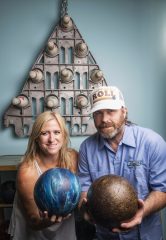
Photo by Danny Fulgencio
The business of bowling
Like many neighbors, the Spiveys’ connection to the theater runs deep. As a 20-year resident of East Dallas, Craig grew up attending concerts when the theater operated as a music hall. Jen also frequented the theater while her dad performed onstage with legendary Dallas rock band the Nightcaps. The band was in show business for 50 years, producing hits like “Wine, Wine, Wine” and “Thunderbird.” The Nightcaps’ music inspired the Vaughan brothers and ZZ Top, which later incorporated a piece of the band’s legacy by recording and copyrighting the latter boozy bash.
The couple may have crossed paths at the theater over the years, but they didn’t meet officially until college while working at a golf course in Austin. Jen attended the University of Texas, and Craig played baseball at St. Edward’s University. Between work, class and practice, both continued to bowl regularly.
When the Spiveys moved back to Dallas, they purchased a house overlooking the theater and kept an eye on its uncertain future. Amid rumors that the space would be partitioned for big-name tenants like Eatzi’s and CVS, they considered making an offer in 2014, but Craig says the timing wasn’t right. They drove by the space again last summer and thought, “Maybe we should try that again,” Jen says.
Transforming the 11,000-square-foot theater into a bowling alley may seem like a daunting task, but the veteran bowling alley proprietors say they were ready to roll. “Failure was not an option,” Jen says. “Lots of times we were like, ‘It’s so huge,’ but it’s so much fun. It erases any fear that you might have. You know it’s going to work.”
Last year, they opened the first Bowlski’s in an old bowling alley near Aspen, Colorado, where people could ski during the day and bowl when the slopes closed. In 2013, the Spiveys also helped open Bowlounge in the Dallas Design District. The retro bowling alley-restaurant sparked a wave of similar concepts, such as Bowl & Barrel, Pinstack and Bowlero. But there were still few bowling options in East Dallas after Jupiter Lanes closed in 2010.
“People love to bowl,” Craig says. “When we opened Bowlounge, we had three- to four-hour waits. There needs to be more activities. There’s a demand for fun stuff to do, other than going to a restaurant or bar.”
Craig says the popularity of bowling is growing alongside the birth of boutique bowling alleys like Bowlski’s. Its opening will be a welcome return to the neighborhood, which has a rich bowling history, he says.
In the early 1940s, bowling was so popular, the newspaper carried league scores and a weekly bowling column, “On and Off Lanes.” Practically every neighborhood company, including the Lakewood Theater, had a bowling league. In 1943, more than 100 teams competed in a citywide tournament at Lakewood Lanes, now Teter’s Faucet Parts on Oram Street. That bowling alley would become the first place Hall of Fame bowler Bill Lillard would roll his first ball when he was a student at J.L. Long.
Neighbors don’t have to be Hall of Fame bowlers to have a good time at Bowlski’s. Craig says he envisions a space for families, date nights, parties, corporate events and recreational leagues.
“Everybody can bowl,” Craig says. “But we’re not just a bowling alley. I have the screen, I have the stage, I have some games and I have some really great food. I built this for the community because I thought it would be fun for everybody.”
- Photo by Danny Fulgencio
- Photo by Danny Fulgencio
- Photo by Danny Fulgencio
- Photo by Danny Fulgencio
Ghosts: Saving the space
Converting the Lakewood Theater into a bowling alley required an extensive makeover, but the Spiveys were careful to preserve the characteristics that earned the art deco building a spot on the list of Dallas landmarks.
The theater’s historic designation meant the tenants had to protect features like the murals that line the walls of the lobby and mezzanine. The murals, depicting classic Disney cartoons and costumed dancers, were created by 1929 Woodrow Wilson High School graduate Perry Nichols, who was also a member of the legendary “Dallas Nine” artists of the 1930s and ’40s.
The murals are perhaps the most well-known interior feature, but the Spiveys also incorporated the work of another famous artist, French sculptor José Martin. A leader in the art deco style, Martin was commissioned for the Opera House in Marseille, France, before immigrating to the United States to work. He came to Texas in 1936 as a sculptor for the Texas Centennial Exposition in Fair Park and completed two life-sized female statues for the Lakewood Theater a few years later. Originally placed inside the auditorium, the statues will take up a new place on the stage overlooking the bowling lanes.
“This isn’t what I dreamed up when I first started, but the theater told me what it wanted where,” Craig says. “It told me how it was going to work and how it was going to flow. It’s been a fun project. It’s like an art piece in here.”
When the Spiveys began renovating the space in July 2018, the couple could hardly breathe for the thick dust in the air. Illuminated by the light of several construction lamps, the particles floated like fog through an otherwise black interior. In an environment like that, it’s no surprise the tenants think they encountered a ghost.
Unexplainable noises and furniture that moved mysteriously overnight made them wonder if the spirit rumored to haunt the neighboring Balcony Club planned to sabotage their renovation. One day while working, a load of steel beams slid off its perch and hurtled toward Craig on the slick floor. As he threw spare metal parts at the load to block its path, it suddenly turned and stopped at his feet.
As the restoration progressed, the ghost must have been satisfied with the Spiveys’ preservation efforts. The antics stopped.
The ghost wasn’t the only preservationist happy with the new-look theater. East Dallas architect Norman Alston, whose firm has addressed several historic structures, stressed the importance of reversibility as an adviser to the couple during the restoration.
“I’m an old-building hugger, and I liked the way it was,” Alston says. “But most of what’s changed is cosmetic. It could turn into a theater again under the right circumstances. Maybe not for me, but for my grandkids. Everybody should take heart.”
The Spiveys kept the original bathroom tile and all the original doors, which they returned to their original color. The mirror shaped like a grand piano is also staying in the lobby. The handrail that has graced the staircase for decades remains, albeit with a modern upgrade. When Craig learned that neon lights once shone under the railing, he mounted his own set of LED bulbs.
As he installed the wiring for the lights under the stairs, he discovered two wallets from the late 1940s scattered among old playbills, ticket stubs and candy wrappers. He hopes to someday return them to the owners or their families.
“The reputation for preservationists is that they want to make older buildings like museums,” Alston says. “Buildings have to adapt. They can be modified, and they can be successful. It’s the normal step in the life of a healthy, older building. People should go there and have fun.”
- Photo by Danny Fulgencio
- Photo by Danny Fulgencio
- Photo by Danny Fulgencio
A new concept
When neighbors walk into the new-look theater, they’ll be greeted by a bellhop and escorted to a familiar art deco candy counter where they will check in and rent their shoes. The lobby remains recognizable with its original doors, murals and patterned carpet, but as patrons continue into the former auditorium, they may be surprised by the changes.
“It looks a lot different,” Alston says. “I’m concerned people will see it for the first time and be a little shocked, but you can still get in there and get a sense of the historic space. The things I care about are still there.”
In the bowling alley, art deco fixtures mix with a steampunk style, which combines Victorian era romanticism with scientific elements from the Industrial Revolution. The roof remains exposed, revealing the woodwork and steel beams, and exposed bowling machines allow customers to see the mechanical operation of resetting pins.
The pinsetters sit toward the back of 10 bowling lanes, complete with ball returns salvaged from an old bowling alley in Mineola, about 85 miles east of Dallas. Reclaimed parts from that business now dot the Lakewood Theater as art or furniture. The TV screens that once showed bowlers their scores have been transformed into chairs, and old bowling ball racks serve as legs for multipurpose tables.
“I didn’t want to put a bunch of new bowling stuff in this old building,” Craig says.
Behind the lanes, neighbors will notice the familiar stage where countless artists, including Gavin DeGraw, Chelsea Handlerand Jen’s dad, performed. It received an upgrade and may be used for live shows and karaoke. The Spiveys can also lower a projection screen to show movies and music videos.
When bowlers get hungry, they can order sliders, called “slideskis,” and pizza rolls, called “rollskis,” at a restaurant and bar to the right of the lobby. The food can be enjoyed anywhere in the space, including the mezzanine stocked with couches and pool tables.
Up another flight of stairs, Bowlski’s has suites with golf simulators and gaming screens that can be rented for parties. The old projector room, fashioned into a VIP speakeasy, can also be reserved for corporate events.
The opening buzz has sparked concerns that parking in the small lot at the Lakewood Shopping Center will be even more impossible. But with Uber and increased foot traffic in the area, the Spiveys think parking problems won’t deter neighbors from checking out the new space.
“It’s been a long time since the community could go to the Lakewood Theater and have something for everybody,” Alston says. “It’s the most unifying thing we have in East Dallas, and it’s great to have it back.”

